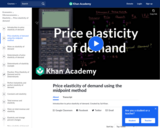
Introduction to price elasticity of demand
- Subject:
- Business and Marketing Education
- Finance
- Material Type:
- Lesson
- Provider:
- Khan Academy
- Author:
- Sal Khan
- Date Added:
- 09/22/2013

Introduction to price elasticity of demand

How changes in the price of related goods can shift demand
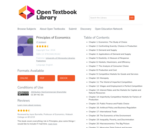
Flat World Knowledge is thrilled to publish a first edition re-launch of Tim Tregarthen’s acclaimed Principles of Economics book, and proud to bring Tim's remarkable talents as a teacher to future generations of students.In 1996, Tim published the first edition of his principles of economics textbook to great acclaim, and it became widely used in colleges around the country. That same year, MS made him wheelchair-bound. The disease forced his retirement from teaching at the University of Colorado at Colorado Springs in 1998. He lost the use of his arms in 2001 and has been quadriplegic ever since.Tim never let his disease get him down. In fact, he turned back to his love of writing and teaching for inspiration. He obtained a voice-activated computer, recruited a co-author, Libby Rittenberg of Colorado College, and turned his attention to revising his principles of economics book.Today we are excited to introduce Libby Rittenberg and Timothy Tregarthen’s Principles of Economics. The authors teach economics as the study of “choice “ by providing students with an accessible, straightforward overview of economics. This text combines the clarity and writing of Tregarthen's seminal periodical "The Margin" with great teaching insights.Rittenberg and Tregarthen help students to understand how real individuals actually work with economics. In this new book, the authors illustrate the practicality and relevance of economics with a variety of new illustrations and insights.The authors take a three-pronged approach to every concept: (1) the concept is covered with a “Heads Up” to ward off confusion, (2) a “You Try It” section makes sure students are staying on top of the concept and (3) a “Case and Point” section that uses a real-world application to harness the concept in reality. For one example of how this plays out in the text see "Chapter 3, Section 2 on Supply." hereThis book is intended for a two-semester course in economics taught out of the social sciences or business school.

Principles of Economics covers scope and sequence requirements for a two-semester introductory economics course. The authors take a balanced approach to micro- and macroeconomics, to both Keynesian and classical views, and to the theory and application of economics concepts. The text also includes many current examples, which are handled in a politically equitable way.
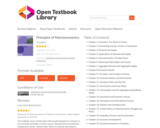
Recognizing that a course in economics may seem daunting to some students, we have tried to make the writing clear and engaging. Clarity comes in part from the intuitive presentation style, but we have also integrated a number of pedagogical features that we believe make learning economic concepts and principles easier and more fun. These features are very student-focused. The chapters themselves are written using a “modular” format. In particular, chapters generally consist of three main content sections that break down a particular topic into manageable parts. Each content section contains not only an exposition of the material at hand but also learning objectives, summaries, examples, and problems. Each chapter is introduced with a story to motivate the material and each chapter ends with a wrap-up and additional problems. Our goal is to encourage active learning by including many examples and many problems of different types.

Principles of Macroeconomics is an adaptation of the text, Macroeconomics: Theory, Markets, and Policy by D. Curtis and I. Irvine, and presents a complete and concise examination of introductory macroeconomics theory and policy suitable for a first introductory course.
Examples are domestic and international in their subject matter and are of the modern era -- financial markets, monetary and fiscal policies aimed at inflation and debt control, globalization and the importance of trade flows in economic structure, and concerns about slow growth and the risk of deflation, are included.
This text is intended for a one-semester course, and can be used in a two-semester sequence with the companion text, Principles of Microeconomics. The three introductory chapters are common to both books.
Lyryx develops and supports open texts, with editorial services to adapt the text for each particular course. In addition, Lyryx provides content-specific formative online assessment, a wide variety of supplements, and in-house support available 7 days/week for both students and instructors.

An adapted version of the OpenStax Microeconomics open textbook, expanded with examples and concepts that are relevant to students at the University of Hawai'i.

Principles of Economics covers scope and sequence requirements for a two-semester introductory economics course. The authors take a balanced approach to micro- and macroeconomics, to both Keynesian and classical views, and to the theory and application of economics concepts. The text also includes many current examples, which are handled in a politically equitable way.

In this lecture, Professor Howie Baetjer of Towson University explains how the market process generates improvements in the human condition, highlighting how profit and loss serve to help people channel their activities in creative and socially useful directions.

Public choice economics uses economic tools to study political behavior. This reading list provides students with an introduction to important concepts in public choice economics, like logrolling and rent seeking, as well as some of the discipline's most important figures such as James Buchanan and Gordon Tullock.

This collection uses primary sources to explore Puerto Rican migration to the US. Digital Public Library of America Primary Source Sets are designed to help students develop their critical thinking skills and draw diverse material from libraries, archives, and museums across the United States. Each set includes an overview, ten to fifteen primary sources, links to related resources, and a teaching guide. These sets were created and reviewed by the teachers on the DPLA's Education Advisory Committee.
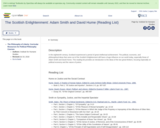
In the eighteenth century, Scotland experienced a period of great intellectual achievement. The political, economic, and philosophical ideas that came out of the Scottish Enlightenment still have a huge influence on our world today, especially those of Adam Smith and David Hume. This reading list provides an introduction to the ideas of the two economists and philosophers, especially on political economy and the nature of justice.

Ever wonder why people don’t do everything for themselves? In this video, Professor Art Carden of Samford University explains how specialization and trade create wealth and make us all better off.

According to Professor Aeon Skoble of Bridgewater State University, the word “value” has very different meanings for economists and philosophers. Economists view value as subjective to reflect individual tastes and preferences. Philosophers, on the other hand, use the term objectively, to refer to concepts such as rights. In this video, Professor Skoble explains how these different conceptions actually compliment each other.

Many people are concerned with growing national debt, but according to Professor Antony Davies of Duquesne University, there are a lot of misconceptions. In this lecture, Professor Davies explores ten common myths about inequality, covering everything from the causes of the debt to potential solutions.
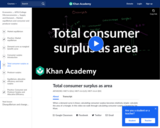
Looking at consumer surplus as area between the demand curve and the market price
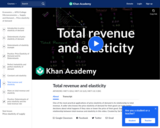
Thinking about how total revenue and elasticity are related

People living together must find some way to preserve common resources. Unfortunately, there are strong incentives for people to exploit these resources when they are held in common by everyone. Professor Sean Mullholland of Stonehill College explains what causes this problem, known as tragedy of the commons, and potential solutions.

Transportation Economics is aimed at advanced undergraduate and graduate civil engineering, planning, business, and economics students, though the material may provide a useful review for practitioners. While incorporating theory, there is a very applied bent to the course, as all the ideas covered are intended to help inform the real decisions that are made (or should be made) in practice.

What is economics and why should you spend your time learning it? After all, there are other disciplines you could be studying, and other ways you could be spending your time. As the Bring it Home feature just mentioned, making choices is at the heart of what economists study, and your decision to take this course is as much an economic decision as anything else.
Economics is probably not what you think it is. It is not primarily about money or finance. It is not primarily about business. It is not mathematics. What is it then? It is both a subject area and a way of viewing the world.